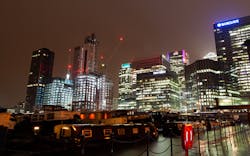Reminder: Conventional lighting is still belching CO2 in Europe
The energy efficiency benefits of LED lighting have now been so long established that sometimes they are either taken for granted or overlooked as the industry draws attention to other advantages provided by solid-state lighting (SSL), such as Internet of Things (IoT)-based data analysis, and circadian health and wellbeing.
So, in case you had forgotten, heed the words of Signify CEO Eric Rondolat.
Lamenting a certain slow political pace at environmental commitments, the boss of the world’s largest lighting company recently issued an impassioned plea for the business and political worlds to ratchet up their actions. He implored them to pay particular attention to the still significant amount of low-lying fruit hanging in commercial buildings and offices, very much including lighting.
“To see how this can play out, we can look to the incredible potential for energy renovation in our built environment,” Rondolat said in backing a new European Commission climate initiative called Fit for 55. “Europe’s aging buildings are our biggest sinks of energy consumption, accounting for 40% of energy consumed and 36% of energy-related greenhouse gas emissions. Yet only 1% of buildings undergo energy efficient renovation per year. This glacial pace cannot continue when the rewards are so tangibly evident in emissions reductions, infrastructure benefits, and job creation across the EU.”
The glacial pace would appear to include lighting, as Rondolat identified 2.3 billion conventional light points still in use across the EU, which, by Signify’s count, is over half of all lighting in the EU. The 2.3B spans professional and consumer settings, and includes incandescent, fluorescent, sodium, and metal halide.
“One of the quickest wins within energy renovation is lighting,” he said. “Replacing the EU’s 2.3 billion conventional light points with energy-efficient LED would save €40 billion per year and eliminate 50.9 million tons of CO2 emissions per year. It’s a quick, non-intrusive intervention that benefits everyone, with an unparalleled payback in speed, cost, and effectiveness.”
Is that all?
No.
“Building renovation is also a major driver of post-pandemic economic recovery,” Rondolat added. “Every €1 million spent on renovation creates 18 local jobs in the EU. An increase in our renovation rate to 3% will create 1.5 million jobs across Europe, with most of the benefit going to local SMEs that make up more than 90% of companies in the building sector.”
The EC’s Fit for 55 is a package of proposals to make the EU’s climate, energy, land use, transport, and taxation policies fit for reducing net greenhouse gas emissions by at least 55% by 2030, compared to 1990 levels.
Fit for 55 aims to make the EU’s European Green Deal a reality, something which its €750 billion Next Generation EU pandemic-related repair and recovery plan also had in mind last summer when the UK’s Lighting Industry Association encouraged more lighting measures as part of the plan. Industry association LightingEurope has also advocated making UV-C disinfection lighting part of Next Generation EU.
Signify has achieved several internal green measures itself, including minimizing plastic packaging and hitting carbon neutrality in its own operations. It also is championing business areas including lighting for food sustainability, solar-powered lighting, and 3-D printing of goods to cut down on the environmental impact of manufacturing.
Ahead of the EC’s Fit for 55 announcement last month, Rondolat joined other business leaders in signing an open letter calling for Europe to up its environmental game. He and others are expected to have more to say in the run up to COP26, which is the 26th United Nations Climate Change Conference, scheduled to run Nov. 1 through Nov. 12 in Glasgow.
MARK HALPER is a contributing editor for LEDs Magazine, and an energy, technology, and business journalist ([email protected]).
For up-to-the-minute LED and SSL updates, why not follow us on Twitter? You’ll find curated content and commentary, as well as information on industry events, webcasts, and surveys on our LinkedIn Company Page and our Facebook page.

Mark Halper | Contributing Editor, LEDs Magazine, and Business/Energy/Technology Journalist
Mark Halper is a freelance business, technology, and science journalist who covers everything from media moguls to subatomic particles. Halper has written from locations around the world for TIME Magazine, Fortune, Forbes, the New York Times, the Financial Times, the Guardian, CBS, Wired, and many others. A US citizen living in Britain, he cut his journalism teeth cutting and pasting copy for an English-language daily newspaper in Mexico City. Halper has a BA in history from Cornell University.





